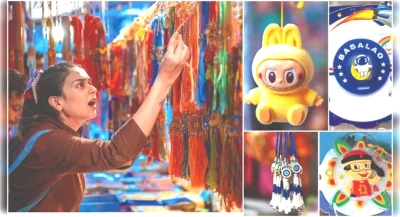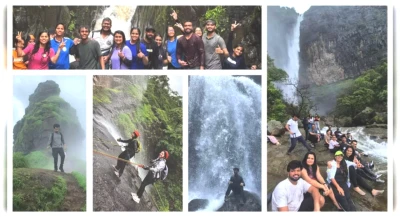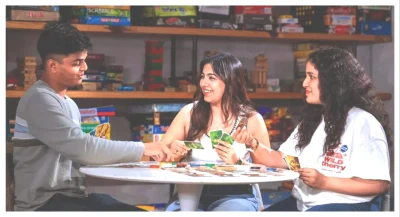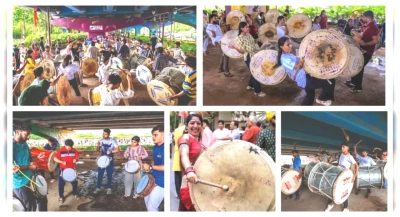Monsoon Treks in Mumbai: Adventure Awaits for Outdoor Enthusiasts!
Monsoon trekking around Mumbai has gained significant traction, evolving from a niche pursuit to a widespread enthusiasm. Adventurers are attracted to the stunning landscapes of the Western Ghats during the rainy season. Although numerous inexperienced groups have surfaced, experts stress the importance of safety and proper equipment. Experienced trekkers are venturing into lesser-known paths, with eco-friendly trekking becoming increasingly popular.
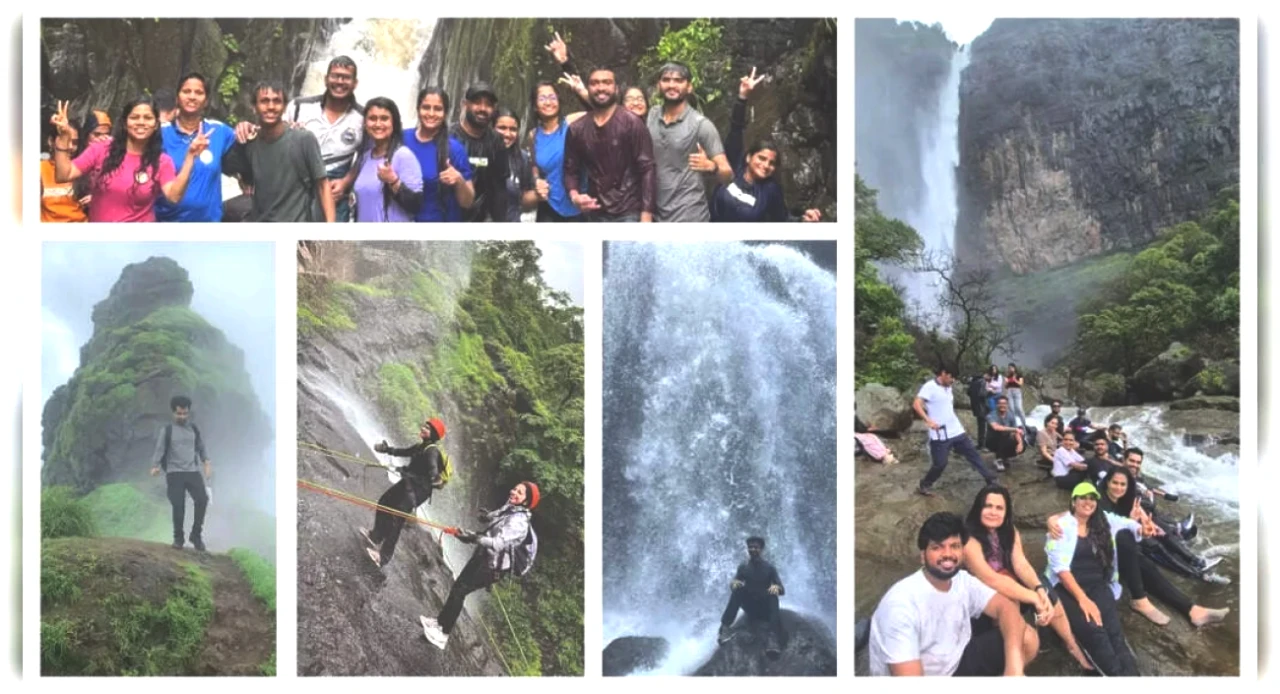
The monsoon season has long been associated with trekking adventures. What initially began as a specialized activity for seasoned mountaineers and fitness fans has now transformed into a widespread enthusiasm among a larger audience. With beautiful waterfalls and trails shrouded in mist, monsoon trekking has become an unofficial ritual for residents of Mumbai seeking rejuvenation. This trend reflects an urban rebellion by those yearning for nature, resulting in a noticeable increase in treks during the rainy season. Whether it's climbing moss-covered forts or wading through streams, these escapes focus on swapping the city's hustle for the dramatics of the great outdoors.
‘There’s been a significant upsurge in rainy season treks’According to Vinay Gupta from Adventure Geek Trekking, “The western ghats offer their peak beauty during July and August, making it the perfect season for reconnecting with nature. The rainy season brings a unique sense of tranquility, surrounded by lush greenery and picturesque vistas, from mountains to rivers and waterfalls, all of which make trekking even more appealing.” Suraj Parab from Sahyardri Rangers adds, “While trekking can be enjoyed all year round, we've noticed a consistent increase in participants during the monsoon months.”
‘Trekking should only be done under expert guidance’Utkarsh Arora from Urban Trekkers warns, “While there are a few certified trek leaders and legitimate trekking companies, there are also numerous unqualified organizers. They promote their services well, lower prices, but compromise on quality and safety. We adhere to strict standards, prioritize safety, and avoid overcrowding.” Suraj notes, “Recently, many trekkers are tackling trails solo, which isn't advisable unless one is experienced. It’s best to trek under trained professionals’ guidance. Nowadays, anyone can form a group and offer low-cost treks, which creates safety concerns. When accidents occur, it forces authorities to close trails, impacting everyone, including well-managed groups.”
‘Serious trekkers are exploring less-known paths’
Harsh Mandavia, an enthusiastic trekker, highlights a trend this year: “Dedicated hikers are increasingly opting for offbeat trails—hidden gems that haven’t yet been inundated by crowds. This month, I participated in two such treks. One involved a brief hike to a secluded waterfall deep within a village forest, guided by a local. We traversed rocky forest paths and finally stumbled upon a breathtaking waterfall where we even got to swim, using a rope to cross to the other side—it was invigorating! The second trek, named Steps to Paradise, involved a challenging two-hour uphill ascent amidst constant rain and chilling winds. The trail was lush yet slippery, revealing a historic fort and the tombs of Maratha soldiers at the summit.”
‘Eco-friendly trekking has become trendy’Many trekking organizers are advocating for clean trekking initiatives, focusing on principles of leaving no trace, zero plastic policies, and educating participants about local biodiversity. “Carrying back trash after treks is essential. We must remember that others will visit these spots too and deserve a clean environment. Moreover, these locations are home to wildlife and should be preserved as nature intended,” emphasizes Dharmesh Barai, a passionate trekker and eco-advocate working on mangrove and wetland conservation efforts.
‘There are numerous trek date options available’The plethora of trek options adds to the allure of monsoon trekking. Vinay shares, “We organize about 50 to 80 weekend treks from June through September. Additionally, we also have one-day treks to nearby forts and mountains which are in high demand.” Suraj mentions, “During the peak monsoon season (July-August), we typically have three to four groups of trekkers each weekend.”
‘Trekking caters to all age groups’Groups of like-minded individuals often form bonds through trekking adventures. Samiksha Shetty, a media professional, states, “I now have a group of friends who are my trekking companions beyond the workplace. We try to go for at least two or three treks each monsoon.” Various groups cater to different demographics, including weekend warriors, office teams, and even women-only treks, all finding a shared connection along the trails. Vinay adds, “We even have trekking experiences designed for kids aged 3-5 with parental supervision, as well as options for those over 50 with good health.”
‘Understanding the importance of proper gear is vital’Experienced trekkers convey that many participants arrive unprepared, as even minor oversights in mountainous terrains can lead to severe outcomes. “I’ve witnessed first-time trekkers, influenced by social media trends, showing up in jeans and regular sneakers, oblivious to the dangers, particularly in rainy conditions. The Sahyadris are stunning but can be extremely slippery. I've seen individuals slip and sustain injuries on wet terrain. Having the right trekking footwear is crucial. It’s not about appearing ‘professional’; it’s essential for safety. Raising awareness about proper gear is paramount,” cautions Harsh.
‘Trekking is inherently adventurous, and accidents can happen’Certain treks present challenges, especially for novices. “We clearly mark trails with both easy and dangerous sections. In tricky areas, trekkers support one another, following strict safety protocols. Adequate coordination among trekkers can ensure smooth experiences. However, accidents can still occur; it’s part of the adventure. Fortunately, we've been lucky so far!” remarks Utkarsh. Harsh reflects, “Once we lost our way mid-hike, resulting in a nerve-racking two-hour journey to reach the base. This experience highlighted our vulnerability in nature without navigation tools or knowledgeable guidance.”
‘We enjoy indulging in local cuisine’“Most trekking companies arrange local food options at the base villages, supporting the local economy. After a hike, nothing beats a fresh meal, which is the best choice,” Utkarsh comments.
TOP MONSOON TREKS NEAR MUMBAI:- Sondai Fort, Near Karjat
Trek Type: Easy to Moderate
Highlights: Iron ladders, village views, hidden water tanks, foggy surroundings
Best For: Beginners and quick day hikes with great Instagram potential - Kalavantin Durg, Near Panvel (Base: Thakurwadi)
Trek Type: Difficult
Highlights: Steep rock-cut steps, vertical thrill, views of Prabalgad & Matheran
Best For: Daredevils and adrenaline seekers (not for the faint-hearted!) - Tikona Fort, Near Pawna Lake
Trek Type: Easy
Highlights: Triangular hill, picturesque views of Pawna dam, steep final ascent
Best For: Beginners, weekend warriors, couples on a scenic exploration - Devkund Waterfall Trek, Near Bhira (Raigad District)
Trek Type: Moderate
Highlights: Hidden plunge waterfall, jungle trail, river crossings
Best For: Waterfall enthusiasts and those seeking the perfect monsoon experience - Naneghat Reverse Waterfall Trek, Junnar (Ghatghar base)
Trek Type: Moderate
Highlights: Historical trade routes, unique “reverse” waterfalls, mist-covered mountains
Best For: Nature lovers, history buffs, and rainy-day romantics - Kalu Waterfall Trek, Malshej Ghat region
Trek Type: Moderate to Difficult
Highlights: One of the tallest waterfalls near Mumbai, ridge walks, breathtaking views
Best For: Waterfall aficionados wanting a quieter, less-traveled path - Rajmachi Fort Trek, Near Lonavala/Khandala
Trek Type: Easy to Moderate
Highlights: Twin forts (Shrivardhan & Manaranjan), lush forest trail, waterfalls
Best For: Beginners and night trekkers - Kalsubai Peak, Igatpuri (3–4 hrs from Mumbai)
Trek Type: Moderate to Difficult
Highlights: Highest peak in Maharashtra (5,400 ft), iron ladders, breathtaking vistas
Best For: A rewarding challenge with spectacular views - Lohagad Fort, Near Lonavala
Trek Type: Easy
Highlights: Expansive fortified walls, "Scorpion Tail" ridge, mist-clad stairways
Best For: Beginners and family treks - Visapur Fort, Near Lohagad Fort, Lonavala
Trek Type: Moderate
Highlights: Scenic waterfall-strewn paths, broad fort ruins, views of Lohagad
Best For: Those seeking a slightly more adventurous alternative to Lohagad - Peb Fort (Vikatgad), Near Neral (Matheran range)
Trek Type: Moderate
Highlights: Caves, ladders, rocky stretches, vistas from Panorama Point
Best For: Adventure enthusiasts and small group hikes - Garbett Plateau, Matheran
Trek Type: Moderate (Long hike)
Highlights: Expansive green plateau, cascading waterfalls, panoramic valley views
Best For: Photographers and landscape aficionados
